The banana spiders are bright-colored arachnids usually found in warm climates. They’re mostly known for their impressive web which they’re fond of weaving. Scientifically, they are known as Nephila clavipes. They have many other common names which include, Golden silk spiders, Calico spiders, Golden orb Weavers, giant wood spider, and Writing spiders.
Following are pictures of how they look like, size, their web, if they’re poisonous, if they can bite humans & pets, their eggs, life cycle and span, habitat plus more facts and frequently asked questions.
Table of Contents
Banana Spider Size
The female banana spiders can reach between 4.5 and 5.3 cm in length while the male spider is normally two-third shorter than the female counterpart. The length they attain is however not inclusive of leg span. The species found in Taiwan are known to exceed the 5.3cm length, with leg span included.
Both males and females are slender and have a different color. The female normally has yellow spots that are located on its light orange abdomen while the males appear dark brown. The legs of the female contain brown and orange stripes and have furry tufts, they also have a third pair of shorter legs.
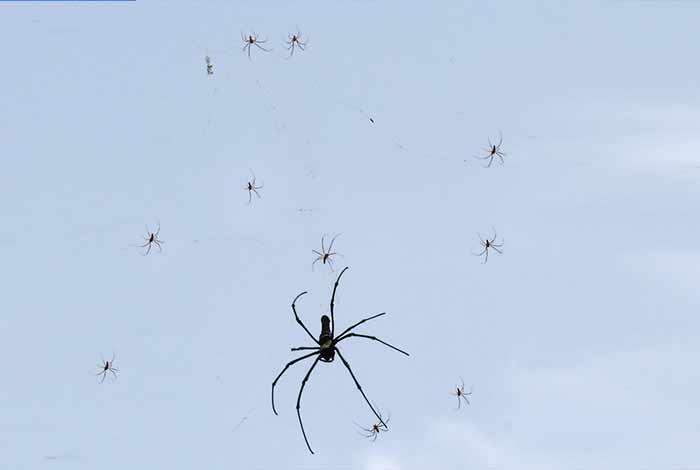
Pictures of what Banana Spider looks like
Following are images and appearance description of both the female and male golden silk spiders.
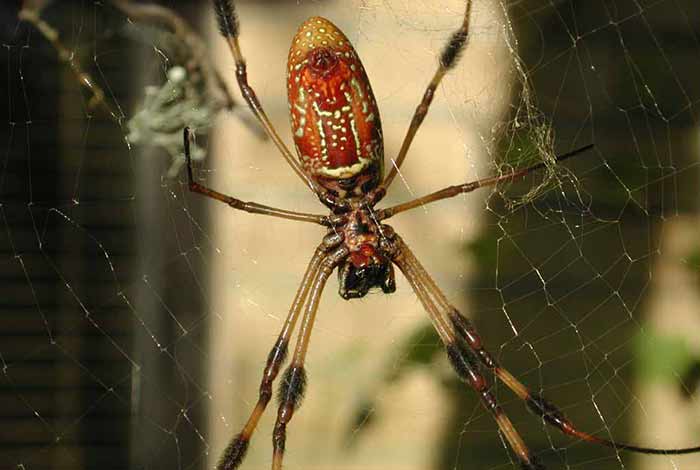
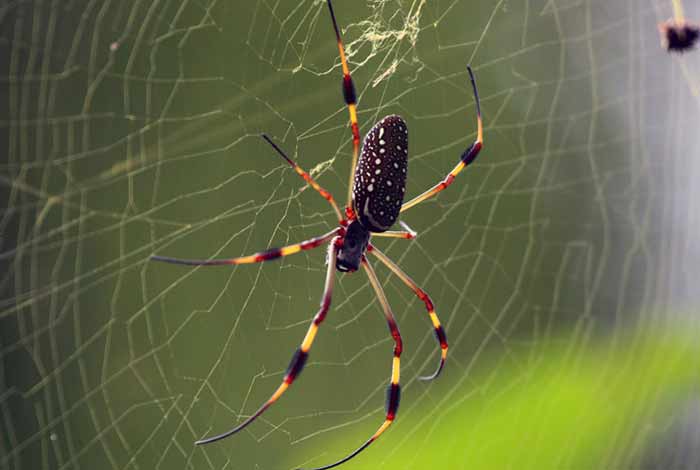
The banana spiders vary in color, some are red while others appear green-yellow and have a distinct white color on the cephalothorax and at the start of the abdomen. The green, yellow, orange color is where they get the name banana. You will hardly find them on banana fruits.
Most of the banana spider species have striped legs. The legs are modified for weaving their webs.
Are Banana Spiders Poisonous/Venomous?
These large arachnids appear threatening but are however shy. The banana spider will only bite you if it feels threatened. Banana spiders produce venom that they use on potential predators whenever they feel threatened. This venom is effective on their prey but poses minimal harm to human beings. If it bites by accident, it should worry you.
Their bite causes symptoms such as blisters, redness, and pain in the bitten region. Allergic reactions to banana spider venom are rare but the venom causes muscle cramps and breathing problems.
The huge body size of the spider translates to a stronger chelicera. This means that whenever they bite, they cause mechanical damage to their prey. The damage they cause to humans is however minimal.
Do Banana Spiders Bite Humans or Pets?
Banana spiders can bite human beings and pets when they feel provoked but, in most situations, they flee when confronted. Their bite will irritate your skin but their bites are never dangerous. The bite along with the side effects often disappears in 24 hours.
There are reported cases of allergic reactions resulting from the banana spider bite. The venom that they secrete and leave on the skin can cause respiratory complications and minor muscle cramps.
When bitten by a banana spider, it is advisable to seek medical attention since allergic reactions can end up causing mild side effects.
Banana Spider Webs
The banana spiders generate asymmetric orb webs that are large. The webs can measure up to 5 feet in diameter. The spiders often remain in these webs so they have a high risk of being spotted by predators. The golden silk orb-weaver produces yellow-colored silk, that it uses to construct these webs.
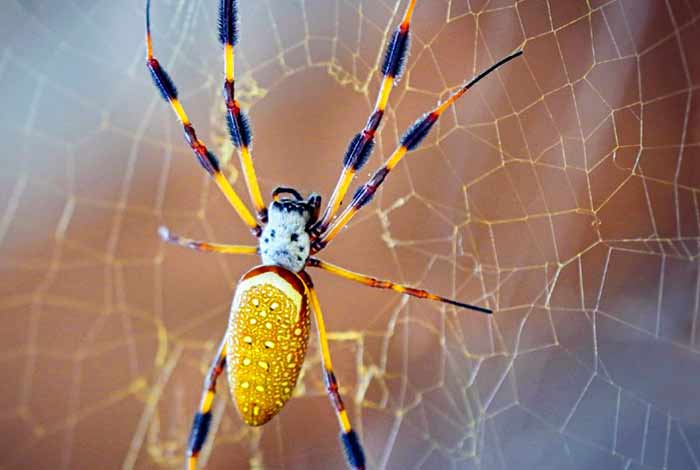
The yellow threads are conspicuous as they shine like gold when exposed to sunlight. Carotenoids, quinones and xanthureic acid contribute to this yellow color. The yellow color serves to scare away bees that are attracted to the web and also acts as camouflage for the spiders. Banana spiders can adjust their body pigment intensity to appear similar to the light intensity and color of the web.
The banana spider webs are complex and have a neatly meshed orb that is suspended in a maze of barricading webs. The webs regularly renewed since the sticky nature of the orb reduces with time.
In sunny weather conditions, adult banana spiders destroy portions of the web and rebuild. The spider devours the portion to be replaced then spins new spirals on the region to be repaired. The web normally contains repellant chemicals that serve to safeguard the web.
The golden orb weaver creates a spiral that contains three to twenty spirals incorporated in between. After weaving the coarse, the spider fills all gaps in the web, creating a manuscript paper effect when viewed in the sun. The web appears as a group of spirals that reflect light and has spaces where the spiral does not reflect light.
Importance of the Banana Spider Silk
- The banana spiders have value due to the silk they produce. The silk is long-lasting and has a unique yellow color. Researchers have put a lot of effort into trying to manufacture garments from this silk, however, no method is commercially viable. Moreover, the golden silk is useful in engineering tissues since it has high mechanical strength and also can retain cell adhesion.
- Some fishermen, all around the world, spin banana spider webs and create balls. They throw the balls in water bodies and use that as bait for fish.
- The banana silk is stronger and more durable as compared to Kevlar fiber. The silk is therefore useful in making bulletproof vests.
Banana Spider Eggs
Female banana spiders usually generate an egg sac around the web that serves to protect the eggs they lay. The females lay their eggs on a silk platform then the eggs are later covered using loose silk, thus forming a sack.
The sac is attached firmly to the web and the surrounding vegetation to provide camouflage, thus the eggs are hidden from predators. The egg sacs contain between 300 and 3000 eggs. The variation in the number of eggs laid depends on the spider species and the mating success.
A survey conducted in urban areas concluded that the banana spiders residing especially in high-end status regions, bear more eggs and are a bit larger than those found in native regions. The possible explanations for this disparity included more food supply and fewer predators and parasites in urban centers.
Upon hatching, spiderlings live in a communal web. The females survive about a month after laying eggs while the male counterparts survive for up to 3 weeks after mating.
In case you accidentally eat the banana spider eggs, then there is no cause for alarm. The eggs laid by the female spider are edible and non-toxic.
Banana spider eggs generally lack pathogens and have a surface containing protein. The eggshell is usually soft while the rest of the egg is made up of lipids and proteins. In essence, spider eggs are nutritious.
More Interesting Banana Spider Facts
- The spider has various names but the most distinct feature that makes it stand out is its web that appears golden. Its web is made out of the one of the strongest materials known to man. In some parts of the world it used for making fishing nets and robes
- The spiders are known to be dimorphic which means that the male and female are dissimilar such that you may confuse and claim they belong to different species.
- Their bright colors is intended to warn and repel predators, in extreme cases, the spider is forced to use venom as a protection mechanism.
- There are numerous banana spiders found in Africa, Australia, Asia, and the United States. This is due to the spiders’ preference for warm climate to induce spider ling hatchings. Spider lings are often carried away by the wind for long distances and some are carried to New Zealand, which offers unsuitable conditions for their development. The spiderlings are usually carried across the Tasman Sea and end up at the North Island.
- The female banana spider normally eats the male after mating. Sexual cannibalism occurs frequently among older females and larger males. Male banana spiders reduce the risk of being eaten by mating whenever females are immobile, this is after molting or whenever they are inactive after they have fed. The moles also approach their female counterparts from the side to increase their chances of survival and increase their mating success.
- The male spider also gets trapped in a females’ web and is eaten by the females before they can escape.
- The banana spider species are the oldest surviving spider species. The fossils retrieved from spiders’ dates back to 165 million years ago.
- Textiles can be manufactured using the golden silk they produce. Some products made include a shawl that was woven in 2004 and a cap in 2002.
- Nephila clavipes is their Latin name that means used to spinning.
- Some smaller spiders can inhabit a banana spiders web and steal food that always gets trapped in the web.
- The golden orb weavers obtained their name from the golden or yellowish color they reflect on their skin whenever light hits it.
- The female banana spider can build a web as wide as a meter.
- These spiders often prey on small to medium-sized insects such as flies, wasps, mosquitos, moths, and grasshoppers. Their prey is mainly flying insects that frequently find themselves caught in the bananas web.
- The arachnids usually incline their bodies relative to the sun, thus maintaining a constant internal temperature. Whenever ambient temperature rises, the spider will move such that the abdomen creates a shade for the cephalothorax.
- They hang using their back legs, that results from intense heat and loss of hydrostatic pressure. When the temperature goes down, the spiders incline themselves perpendicularly to the sun, thus retaining the most heat energy they can conserve. In extreme temperatures, the female spiders leave their webs and seek alternative habitat.
Frequently Asked Questions
Where do banana spiders live?
Banana spiders mainly reside in webs. The female spiders are the main architects. The webs form a habitat for the banana spiders in conducive environments. During harsh weather conditions, banana spiders often relocate to more suitable habitats.
How long do banana spiders live?
Female banana spiders live longer than their male counterparts. Female spiders live for about a month after molting while the male spider only survives for up to 3 weeks after molting. Various factors cause this disparity, but the main factor that contributes to the shorter male life span is insect cannibalism. Female banana spiders often consume male spiders.
Where are they found (countries)?
The banana spiders are mainly located in Africa, Asia, the United States of America and Australia. In the US, the spiders are mainly located in southeastern states. Besides, banana spiders build webs made from silk.
What do banana spiders eat?
Banana spiders often prey on small to medium-sized insects such as flies, wasps, mosquitos, moths, and grasshoppers. Their prey is mainly flying insects that frequently find themselves caught in the bananas web.
What should I do when bitten by a banana spider?
Banana spiders secrete a venom that is harmless to human beings. When bitten, you can use some home remedies such as anti-histamines or place ice on the spot. In case you develop complications such as allergic reactions, seeks immediate medical attention.
Are banana spiders useful?
Yes, they are useful in fields such as horticulture and the fashion industry. In the horticulture sector, the spiders are useful in pollination while in the fashion sector, the silk they produce is useful in creating pieces of fabric.
They’re insect predators which means they will prey on some insects which cause damage.
How many eyes does a banana spider have?
These spiders are strange creatures since they have eight eyes. Other than that, they have a head and an abdomen. They also have eight legs.
Banana Spiders vs Black and Yellow Garden Spider.
How different or similar are they? Nephila clavipes and Yellow Garden Spiders (Argiope aurantia) have similar features which may lead to confusion in the identification process. The fact is, they are closely related but they are not the same.
Banana spider females have distinctive feathery tufts or gaiters on the lower segments of their brown-and orange-banded legs as shown in the image below.
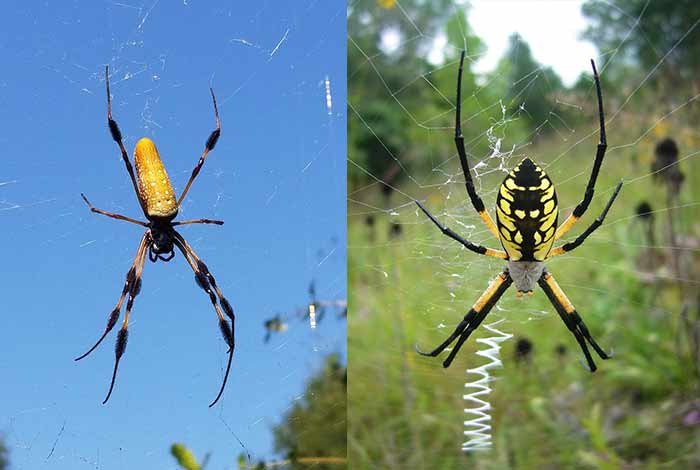
References
- https://www.healthline.com/health/banana-spiders-bites
- https://aggie-horticulture.tamu.edu/galveston/beneficials/beneficial-49_banana_spider.htm
- https://www.nationalgeographic.com/animals/invertebrates/group/spiders/
- https://en.wikipedia.org/wiki/Nephila
Further Reading